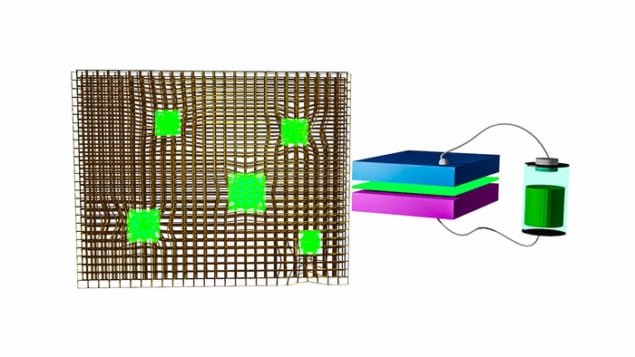
Perovskite nanocrystals are promising materials for light-emitting diodes (LEDs), but they tend to clump together – an instability that destroys their light-absorbing and light-emitting properties. Researchers in the US have now succeeded in stabilizing these materials in porous structures known as metal-organic frameworks (MOFs). The resulting films, which can be fabricated at room temperature, could have applications in consumer electronics and medical imaging as well as photovoltaic devices.
Perovskites are low-cost, easily-processed crystalline materials made from earth-abundant elements. They have an ABX3 structure, where A is caesium, methylammonium (MA) or formamidinium (FA); B is lead or tin; and X is a halide (chlorine, bromine or iodine). They absorb light over a broad range of solar spectrum wavelengths thanks to their tuneable bandgaps, and the colours they emit can also be continuously tuned throughout the visible spectral range. All these properties make them better than classic LED materials, but – as is so often the case in materials research – there is a snag: because the nanocrystals tend to clump together, the material degrades back to a bulk phase, which is useless for LEDs.
Avoiding clumps
A team led by Wanyi Nie from the Center for Integrated Nanotechnologies at Los Alamos National Laboratory has now found a way to avoid this clumping by building the crystals inside MOFs. These porous, cage-like structures effectively separate the crystals from each other, thereby preventing them from merging.
The researchers took their inspiration from pioneering work on perovskite-MOF (PeMOF) powder synthesis. Researchers have known for a while that the lead metal cores in a lead-MOF can react with the organic halide salt in the perovskite, resulting in non-interacting perovskites crystals assembled around the metal nodes. Instead of working with powders, however, Nie and colleagues focused on making highly uniform thin films suitable for device fabrication.
“We began by making a lead-MOF thin film, whose thickness we could control, and then introduced an organic halide solution, in this case methylammonium bromide, into the MOF,” explains team member Hsinhan Tsai. “We then converted the top layer of the film into a perovskite-MOF structure.”
Bright red, blue and green light
This concept of combining perovskite nanocrystals in an MOF had been demonstrated before in powder form, but this is the first time anyone has successfully integrated it as the light emitting layer in an LED, Tsai adds. The method is based on a solution-coating approach that is far less expensive than the conventional vacuum processing techniques routinely employed to create inorganic LEDs today.
The MOF-stabilized LEDs can be fabricated to create bright red, blue and green light, as well as varying shades in between. Nie notes that the devices also display an improved colour purity and a higher photoluminescence (PL) quantum yield, which is a measure of a material’s ability to produce light.
The researchers tested their materials by exposing them to ultraviolet radiation, heat and an electrical field. None of these factors caused the materials to degrade, and the tests showed that they did not lose their light-absorbing and light-emitting efficiencies either. Using optical and X-ray spectroscopy at the Advanced Photon Source (a Department of Energy facility at Argonne National Laboratory), the team also discovered that the bright light emission comes from carriers (electrons and holes) recombining in localized regions of the structure. The PL intensity changes very little with temperature, explains Tsai, because the system is free of traps. These are defects that can trap electrons and holes, preventing them from recombining and thus making it so they can’t emit light.

Ultraporous metal-organic frameworks could make clean energy carriers
As for applications, Tsai tells Physics World that as well as LEDs, the new PeMOF structures might come in useful as radiation scintillators for medical X-ray imaging. “We also expect them to be used in photovoltaics applications, by tuning the perovskite composition so that it absorbs solar spectrum wavelength radiation,” he says.
The researchers, who report their work in Nature Photonics, say they now plan to tune the colour emitted by the structures into the blue region of the spectrum. “Blue LED technologies are the basic element for white light emission and there aren’t many materials that can emit this wavelength efficiently,” Tsai says.



